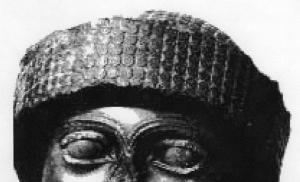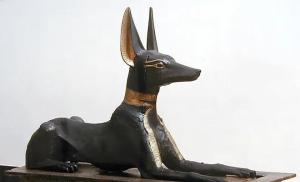White hare: description, habitat, what they eat and how they reproduce. Interesting facts about hares: varieties and lifestyle of eared jumpers Comparisons of the white hare and the brown hare differences
Hares are common animals. They are playing important role in the forest community and in human life. People are doing commercial hunting for hares, obtaining dietary, tasty meat and valuable fur and skin. IN wildlife There are several dozen species (30) of these animals, but the most common are two: the hare and the hare. How they look, where they are common, and what are the similarities between the white hare and the brown hare, read the article.
Similar features
Hares of any kind primarily belong to mammals and belong to one family - the hare. These animals have other similarities:
- The ears are very long.
- The collarbones are underdeveloped.
- The hind legs are much longer than the front legs and they are very strong. Thanks to this, hares can run at a speed of 70 km/h.
- The tail is short and fluffy.
- Females are larger in size than males.
- Animals shed twice a year: in spring and autumn periods. The duration of this time depends on external conditions. In spring, most species begin to shed their old coats from the end of winter, starting from the head. In autumn, molting begins in September from the rear.
Brown hare
Belongs to the hare family, differs large sizes, thanks to which it cannot be confused with other species. Body length reaches 68 cm, weight - 4-7 kg. Ears and tail can reach a length of 14 cm. summer period The hare has a gray color with different shades. In winter, it depends on the habitat: in middle lane The color does not change, except that it becomes lighter. But in the northern regions of residence, the fur of the hares becomes white with a dark stripe on the back.
Spread of the hare
These hares live in the steppe, tundra zone, and forest-steppe. They are characterized by the European steppe massifs, as well as the North African continent. These animals are common in Asia. The habitat in the north is limited to the territories of Ireland, Scotland, Finland, and Sweden.
In the south, the habitat of the brown hare borders Turkey, Iran, Arabia, Africa, Transcaucasia and northern Kazakhstan. This species of animal was brought to North America in late XIX centuries. In our country, hare are common in the European part, southern Siberia, and the Far East.
In honor of this animal, known since ancient times, there are interesting fairy tales for children and many fables in which the hare is called “gray”, “cowardly”, “brave”, “cunning”.
White hare
This animal from the hare family is a large representative of its genus, but compared to the brown hare it is much smaller. Its weight reaches two to three kilograms, sometimes more than four, its body is 45-70 cm, its ears and tail are up to 10 cm. Color is directly related to the time of year. In summer, the skin becomes gray with reddish or dark shade, brown spots are visible on the fur. The head is darker than the body, but the stomach, on the contrary, is darker white. In winter, the white hare's skin is pure white. The animals molt twice a year, like all representatives of this species.

Where does the white hare live?
The distribution area of this species includes China, Mongolia, Japan, Northern Europe, South America. In our country, the hare lives over a vast territory: from Transbaikalia and the Don to the tundra itself. This animal lives in small forests that are located near ponds and agricultural lands. Prefers open places with rich grass and berries.
Whites are lovers of a sedentary lifestyle. They migrate short distances only when necessary due to bad weather or lack of food. But in the tundra zone, their migration over long distances is widespread. Hares are forced to migrate due to lack of food, which is located under a layer of high snow.

White hare and brown hare: similarities and differences
Despite the fact that the white hare and the brown hare belong to the same species, there are a number of differences between them:
- The hare is larger than the hare.
- Rusak is more different long ears and hind legs.
- The hare has wider paws than the hare. Their feet are covered with thick fur, thanks to which they winter time The animal easily moves through snow, even loose snow.
- The hare has slightly wavy fur.
- Favorite place The hare's habitat is forest, and the hare's habitat is meadows, arable lands, and copses.
- In winter, the hare's fur is snow-white, only the tips of the ears are black. The brown hare is never pure white in color; it only lightens slightly in winter.
- The hare has a shorter tail, round shape, and the hare's is long, wedge-shaped.
If you compare the white hare and the brown hare, you can find similarities between them.

- These animals have ears and hind legs- long.
- In summer they have the same color - gray.
- They are born immediately with fur and sighted. Exceptions are rare cases when there is no covering on the body. They grow up very quickly. Even in at a young age Hares are able to defend themselves.
- In times of danger, they flee from enemies and do not hide in holes like rabbits.
- They prefer to live separately. They form a pair only during the mating season.
- The food is hard food - the bark of trees and shrubs, small twigs, buds, shoots.
- They do not store food for future use.
- They have high fertility: they can bear offspring up to eight times a year. The female carries the hares for 1.5 months. Ready to mate immediately after giving birth.
The role of the hare in human life
The lifespan of this animal species in the wild is six to seven years. Rarely, but there are exceptions when the hare lives 12 years or more. The brown hare is valuable for its fur and meat, which is why it is included in the list of game animals. Felt is made from skins High Quality, and also sew fur products.

But there are many countries where the brown hare is considered a malicious pest agricultural crops. Indeed, these cute animals harm winter crops and fruit plantings. Hares are capable of eating the entire vegetative part of 15 trees in just one night. In addition to harming agricultural plants, these animals are carriers of diseases such as brucellosis, coccidiosis, tularemia and others that affect humans, and in severe forms.
The white hare (lat.Lepustimidus) is a mammal from the order Lagomorpha.
The body weight of this animal ranges from 1.6-4.5 kg. The ears are 7-10 cm long, the tail is short, round in shape, averaging about 7 cm.
The white hare has wide paws. The feet and the space between the toes are densely covered with hair. The color of the white hare's fur varies depending on the season: in summer the animal is gray or reddish-gray, and in winter it is white with slight black spots on the tops of the ears.
Shedding occurs twice a year: in autumn and spring, depending on changes in duration daylight hours and average daily temperature. In regions where there is little snowfall, hares do not change color. Female white hare are usually slightly larger than males.
Lifestyle of a hare
The white hare is active in the evening and predawn. In summer the animal does not make special shelters for itself, but in winter it can dig a small hole in the snow in which it hides daytime or in bad weather.
White hare lead a relatively sedentary lifestyle, living on average on an area of 10-15 hectares. If there is plenty of food, the hare does not travel even two kilometers during the night. However, in search of food, the white hare is able to travel long distances - up to 10 kilometers in one night.
White hare feeding
White hare is a herbivore. Its summer diet consists of the green parts of most herbaceous plants - this can be clover, all kinds of cereal grasses, dandelion leaves and flowers, yarrow and many medicinal plants growing in the territory it occupies. In winter, it is more difficult for an animal to find food for itself.
At this time, white hare feed on the bark of some deciduous trees, such as birch, willow, aspen, sometimes immature branches of bushes. Dry grass, and even cedar cones, are taken out from under the snow and eaten. They can wander into private estates and gnaw the bark of fruit trees.
The winter diet may also include dry berries remaining on the branches of bushes. There have been cases where hares have dug up and eaten truffle mushrooms.
White hare breeding
Mating occurs in spring and summer. Usually 5-7 hares are born, in rare cases the number of cubs is 10-11. There may be 2-4 broods per season, depending on the amount of food and the age of the female. A female's pregnancy lasts on average 50 days. The cubs emerge sighted and ready to move independently. At first (8 days) they feed purely on mother’s milk, then little by little they try grass. After 14-15 days, the hares begin independent life, at 10 months they reach sexual maturity. Life expectancy is 17 years, however, many individuals do not live even 5 years.
Habitat of the hare
The white hare lives near lands where there is plenty of food both in winter and summer. The natural habitat is the illuminated edges of deciduous and mixed forests, thickets of bushes. It can hide in tall steppe grasses, in reeds near water bodies - in places rich in food and where predators cannot reach it.

Natural habitat of the white hare
How view of the hare distributed mainly in northern latitudes– boreal forests of Northwestern Europe (northern Poland, Scandinavia, northern Great Britain, Sweden, Norway), in North America, in the European part of Russia, in the tundra forest zone throughout Siberia, Kamchatka and Sakhalin.
Within Ukraine, separate populations are found in Sumy, Chernihiv and Zhytomyr regions.
The number of white hare and the reasons for its change
In 2010, about two hundred individuals lived in Ukraine white hare species: the largest population (150 individuals) was found in the Sumy region, slightly less in the Rivne (30 individuals) and Chernigov (20 individuals) regions.
Reasons for population decline in Ukraine:
- warmer climatic conditions;
- poaching;
- increase in the number of predators (mainly foxes);
- deforestation.

Hares are perhaps the most common animals in our country. Despite the fact that they are a favorite trophy of many hunters, their numbers are practically unchanged, since due to their fertility, these animals reproduce very actively.
There are about 30 species in total, all types of hares are slightly different external features and habits.
Appearance
If you take general description hare (mammal, hare family), then it should be noted that all species have similar features:
- long ears;
- underdeveloped collarbones;
- long and strong hind legs;
- short fluffy tail.
Females are larger than males, the size of animals ranges from 25 to 74 cm, and weight reaches 10 kg.
Thanks to its long hind legs, this animal is able to run fast and jump. The running speed of a brown hare, for example, can reach 70 km/h.

Shedding
These animals molt twice a year, in autumn and spring. The onset and timing of molting are related to external conditions. Molting begins when the length of daylight changes, and its duration is determined by air temperature.

Spring molting in most species begins in late winter - early spring and lasts on average 75-80 days. The animal begins to shed from the head to the lower extremities.
Autumn molting, on the contrary, begins from the back of the body and moves to the head. It usually begins in September, and molting ends by the end of November. Winter fur grows thicker and more lush, it protects the animal from the cold.

Varieties
There are four common species in Russia: the Manchurian hare, the sandstone hare, the white hare and the brown hare. Let's look at them in more detail.
Manchurian
This species has much in common with wild rabbit, but it’s still difficult to confuse them, since the Manchurian hare looks a little different.
This is a small animal no more than 55 cm long and weighing up to 2.5 kg. The length of the ears is about 8 cm. The fur is hard and thick, brownish-ochre in color. The belly and sides are lighter than the body; there are several dark stripes on the back.
The habitat of this species is Far East, Korean Peninsula and Northeast China. In cold weather, this species experiences seasonal migration over short distances, during which animals move to places where there is less snow.
In nature, the species is not very widespread and has no commercial significance.

Sandstone
This species is also called tolai or talai. Compared to the Russians, it is quite small. Length 40-55 cm, weight up to 2.5 kg. But the tail and ears are longer: the length of the tail reaches 11.5 cm, the ears - up to 12 cm. Narrow paws are not adapted to move on snow. In summer, this species has grayish-buff fur, white on the throat and belly, and always remains dark on the rest of the body. The molting period largely depends on the habitat and weather conditions.
Tolai chooses flat areas, deserts and semi-deserts for life, but sometimes climbs high into the mountains. In Central Asia it can be found at an altitude of 3000 m above sea level. Often this hare lives in a hole abandoned by another animal; it rarely digs holes itself.

Tolay leads settled life and migrates only in case of severe deterioration in weather conditions or in case of acute lack of food.
This species reproduces less frequently than others - 1-2 times a year, but since it is not hunted often, a decrease in numbers is not observed.
Tolay is widespread in Central Asia. It is also found in Transbaikalia, Mongolia, Southern Siberia and some provinces of China. In Russia, tolai lives in Altai, in Astrakhan region, in Buryatia and the Chui steppe.

Belyak
Description of the hare: this is a fairly large representative of the hare family. How much does a hare weigh? The average weight of a white hare is 2-3 kg, and can reach up to 4.5 kg. Body length is from 45 to 70 cm, ears - 8-10 cm, tail - 5-10 cm. This species has wide paws. Thanks to its feet covered with thick hair, the hare moves easily even on loose snow in winter. The color depends on the time of year. In summer, the skin is gray - dark or with a reddish tint, with brown spots. The head is darker than the body, the belly is white. In winter, the white hare's skin becomes pure white. She sheds twice a year, in autumn and spring.
Where does the white hare live? In Russia, the white hare inhabits most of the territory from western Transbaikalia and the upper Don to the tundra. Also large populations of this species live in China, Japan, Mongolia, South America and in Northern Europe.

For life they choose small forests, located near bodies of water, farmland and open spaces, places rich herbaceous plants, berries. They lead a sedentary lifestyle, occupying an area of 3 to 30 hectares, migrating only in case of severe bad weather and lack of food supply. Long-distance and mass migrations of the hare are observed only in the tundra zone, where the snow cover in winter is so high that the hare’s food (low-growing plants) becomes inaccessible.
They breed 2-3 times a year, and there are up to 11 hares in a litter. The lifespan of a hare in the wild is from 7 to 17 years.

Hare
The brown hare is larger than the hare. With a body length of 57-68 cm, it weighs from 4 to 7 kg. The length of the ears is 9-14 cm, the tail of the hare is 7-14 cm. The hare has longer and narrower paws than the hare.
This hare is gray in summer with an ocher, brownish or reddish tint. In winter, the gray hare living in the middle zone practically does not change its color, only becoming a little lighter. Animals inhabiting northern regions, become almost white, leaving only a dark stripe on the back.
Where does the brown hare live? In Russia, Russians inhabit the entire European part, area Ural mountains, in Southern Siberia, Khabarovsk Territory and territories near Kazakhstan, in Transcaucasia in the Caucasus and Crimea.

Brown hare populations also inhabit Europe, the USA, Canada, Asia Minor and Asia Minor.
What does the hare eat? Since it is a herbivore, its diet consists of green parts of plants: clover, dandelion, mouse peas, yarrow, and cereals.
The brown hare is a steppe hare; it chooses open spaces to live; it rarely lives in forest areas and in the mountains. The animals lead a sedentary life, occupying an area of 30 to 50 hectares. Seasonal migrations occur only among Russians living in mountainous areas. The brown hare descends from the mountains in winter, and climbs back to higher ground in summer.
They reproduce depending on the habitat and weather conditions, from 1 to 5 times a year. There are 1 to 9 hares in a litter. How many years does a hare live? Average duration The life of a hare is 6-7 years.

Habitats
Hares are distributed almost everywhere. Their populations are numerous and inhabit all continents. Antarctica - the only place on land where these animals do not live.
Lifestyle and habits
This eared animal leads twilight night image life. During the day, the animal rests on ditches. True, in places where there is a high number of obliques, the habits of the hare change and, often, it is active during the day.
Unlike rabbits, the scythe does not dig deep holes. A hare hole is a small depression in the ground, under bushes or tree roots. These animals choose their beds depending on the terrain and weather conditions. In warm, clear weather, they can roost almost anywhere if there is at least a small shelter nearby. In winter, finding places to lie down is not a problem at all, since hares sleep right in the snow.

The oblique runs very fast, while running it often makes long jumps and can suddenly change direction. This method of movement helps the animal escape from the predators pursuing it. Eared cunning creatures are excellent at confusing their tracks. At the slightest threat, the animal freezes motionless until it considers that nothing threatens it anymore.
Many people wonder if hares can swim. Although they do not like water and try to stay away from it, they swim well.

Nutrition
The diet of the oblique is very varied. What a hare eats depends on the season, weather conditions and habitat.
In summer
In summer, this herbivorous animal eats more than 500 species of plants, preferring their green parts. Also loves to eat melons, vegetables and fruits. Animals often get out into the fields and raid vegetable gardens and orchards. In autumn, their diet includes more and more solid food. Withered grass, roots and branches of bushes become their main food.
in winter
What do hares eat in winter, when there is no greenery?
The thicker the layer of snow, the harder it is for the long-eared animal to obtain food. High snow levels can hide almost everything that hares eat in winter. Animals save themselves from hunger by moving closer to settlements. Help them out in harsh winters haystacks, frozen berries on bushes and fallen fruits that animals dig out from under the snow.
Tree bark makes up the majority of the diet during the cold season. Usually the scythe selects soft trees: aspen, birch, willow and others.
in spring
In spring, the diet becomes significantly more varied due to buds, young shoots and fresh grass. To make up for the deficit nutrients, the long-eared eats pebbles, earth and even animal bones.

Reproduction
The weather conditions directly determine when the hares begin mating. IN warm winters the rut can begin in January, and after frosty winters- in the beginning of March.
During the mating season, these animals communicate by tapping a certain rhythm on the ground with their front paws. Males compete for the attention of females, engaging in spectacular fights.

Young individuals are ready for reproduction at the age of one year. Most species produce offspring several to five times a year, with an average of 2-5 cubs per litter. Despite the fact that the rabbits are born developed and sighted, for the first days they practically do not move, hiding in a hole.
The female leaves the brood almost immediately after giving birth and only occasionally returns to feed the cubs. Since females have offspring at the same time, any hare that comes across hungry cubs will definitely feed them. This behavior is easy to explain. Baby hares have no smell, unlike adults, and the less often the female is near them, the less chance the cubs have of becoming prey to a predator.

Hunting
Hare hunting is popular in our country. This animal is an object of fur trade and sport hunting. IN large quantities These animals are hunted for their fur and tasty, nutritious meat.
Hunting begins in October before snowfall and lasts throughout the winter. There are many ways of hunting: by tracking, in blinds, in powder, with dogs and “in the wild”.
The scythe has many enemies in nature besides hunters. They're hunting him predator birds, wolves, bobcats, coyotes and foxes. High fertility helps these animals maintain their numbers.
Video
Hares are one of the most common animals in the world. Even though they have very valuable fur, being for this reason a favorite object for hunting, hare fertility does not allow this population to disappear.
In total, there are 30 species of hares in the world, each of them differs in its habits and external features. Let's talk today about one of them - the white hare.
White hare Description of the hare
So why the white hare? In winter, this subspecies of hare changes its color from gray (sometimes grayish-reddish) to snow-white. Only on the tops of the ears may there be black spots.
The weight of the hare ranges from 1.6 kg to 4.5 kg, the length ranges from 40 to 65 cm. The animal has a neat round tail, the length of which barely reaches 7 cm, and luxurious ears from 8 to 10 cm long. The species is always wide, the feet and toes are covered with thick fur.
The molting period for hares of this species occurs in spring and autumn - 2 times a year. In those regions where snow falls in small quantities, white hares do not change color.
Females are most often somewhat larger than males.
Habitat
 So where does this snow-white beauty live? This species is most widespread in northern latitudes - North America, Scandinavia, Norway, Sweden. In Russia, the hare can be found in Siberia, Kamchatka and Sakhalin, in Ukraine - in the Chernigov, Zhitomir and Sumy regions.
So where does this snow-white beauty live? This species is most widespread in northern latitudes - North America, Scandinavia, Norway, Sweden. In Russia, the hare can be found in Siberia, Kamchatka and Sakhalin, in Ukraine - in the Chernigov, Zhitomir and Sumy regions.
Whites prefer to live in places where there is plenty of food for them, regardless of the time of year. Most often, these beauties can be found on the edges of mixed and deciduous forests, in thickets of bushes, in reeds near water bodies, and in tall steppe grasses. The hare tries to settle where predators cannot reach it.
Nutrition
What do hares eat? Whites belong to the category of herbivores:
- In summer time these long-eared creatures love to eat herbaceous plants such as clover, grasses, dandelion leaves and flowers, yarrow, goldenrod and many other medicinal plants that grow in their habitat.
- Hares in autumn feed on small branches of bushes.
- In winter these beauties they feed on the bark of trees such as aspen, birch, willow, etc. They can get dry grass and cedar cones from under the snow. Sometimes they eat dry berries left on the bushes. It can also eat rowan, rosehip, juniper and alder. If there are orchards not far from the hare’s habitat, then there you can also find a hare gnawing on the bark of fruit trees.
- In the spring this fluffy again switches to herbaceous plants and young shoots of trees and shrubs.
There have also been unusual cases - gourmet hare hare found, dug up and ate truffle mushrooms.
Lifestyle
What is the behavior of the white hare? Their highest peak of activity occurs in the evening and predawn.
In winter, white hares dig themselves a small hole in the snow, where they hide in bad weather or daylight hours days. In summer, white hares usually do not make such shelters, but settle down in a secluded place simply by trampling down the grass.
From their place of refuge to their feeding place, hare whites generally move along the same route. This becomes especially noticeable in winter - they trample the paths so well that even a person can move freely along them.
In search of food, this long-eared animal is capable of moving very long distances - up to 10 kilometers in one night. But if the long-eared one has enough food, then in the same night he can walk only one kilometer.
The hare has very poorly developed vision and sense of smell, but it has excellent hearing. The ability to move very quickly is the only means of defense in case of danger.
Reproduction
 The white hare, like all its long-eared brothers, is a very prolific animal. Mating season usually occurs in spring and summer months. In females, peak fertility occurs between 2 and 7 years of age. Pregnancy lasts from 47 to 55 days; soon after giving birth, the hare mates again. In one season, a female is capable of raising from 2 to 4 broods, depending on her age and nutrition. Lambing occurs in a secluded place on the surface of the earth. The first bunnies are born in April-May, the second in June-July, the third in August-September. Rarely, the first babies appear already in March, and the last ones in November, but such litters usually die.
The white hare, like all its long-eared brothers, is a very prolific animal. Mating season usually occurs in spring and summer months. In females, peak fertility occurs between 2 and 7 years of age. Pregnancy lasts from 47 to 55 days; soon after giving birth, the hare mates again. In one season, a female is capable of raising from 2 to 4 broods, depending on her age and nutrition. Lambing occurs in a secluded place on the surface of the earth. The first bunnies are born in April-May, the second in June-July, the third in August-September. Rarely, the first babies appear already in March, and the last ones in November, but such litters usually die.
In one litter, on average, 5–7 hares are born, but sometimes up to 11 are born. Babies are born covered with thick fur, sighted, unlike many other animals, and capable of independent movement. The weight of newborns is only 100–130 grams.
For the first 8 days, the hares feed exclusively on their mother’s milk, after which they begin to try grass. Since rabbit milk is very fatty and nutritious, babies eat it no more than once a day. After 15 days, the cubs already move away from their mother and lead an independent life. White hare reaches puberty at the age of ten months.
The lifespan of this hare is 17 years, but, unfortunately, most of them do not live even to 5 years - this is due to predators, poaching and infections.
Number
The number of white hare, as well as its brothers, changes from year to year.
Conservation of this species
- White hare listed in the Red Book of Ukraine as an endangered species.
- Included in the Red List International Conservation Community.
- Is under protection Berne Convention.
The brown hare is the largest of the hare family, its length can reach 70 cm and its weight is 7 kg. On average, an adult hare weighs 4–5 kg. Its ears are longer than those of the hare (100–120 mm) or more a long tail, having a pointed shape.
The tips of the ears are dark, almost black. The general color of the coat is yellowish-fawn-brownish, with grayish sides and a lighter belly and neck. On the back there is a forelock belt, or saddle. In winter, the hare becomes significantly lighter (sometimes even white), but never completely white. The color of the winter outfit largely depends on the permanent habitat: whether it is open snow-covered fields or dark weeds. The undercoat has a pronounced undercoat with slightly curly guard hairs. The long hind legs are covered with dense, close-lying hair of medium hardness. The running speed of the hare is higher than that of the hare and reaches 50 km/h. The brown hare is originally a steppe animal, but is also widespread in the forest-steppe zone. With development Agriculture and due to deforestation, the range of the hare has expanded significantly.
 Tails of hares: a) hare b) hare
Tails of hares: a) hare b) hare
Many Russians settle along the edges of forests and in bushes. The hare leads a sedentary lifestyle, stubbornly preferring the places where it was born. The hare lies down for the night within a radius of 400 m from its previous bed, and only, repeatedly frightened by persecution, does it leave these places forever. A hare scared, for example, on stubble will not return here the next day, but will lie down in a forest belt or forest plantations, but a day later it will be in the same place. In the steppe zone, during foodless winters, hares sometimes migrate en masse to  looking for food. As long as the height and looseness of the snow cover allow, the hare will feed on winter crops. With strong crust or very high snow cover, it becomes a pest of garden trees or fattens along the edges of forest belts and forest areas. With the onset of a thaw, he returns to his favorite food. On hard ground it lies down without making a den, but in loose ground it digs a hole about 8 cm deep and lies down with its head down on its outstretched front paws and its ears flattened. His keen hearing allows him to constantly monitor his surroundings.
looking for food. As long as the height and looseness of the snow cover allow, the hare will feed on winter crops. With strong crust or very high snow cover, it becomes a pest of garden trees or fattens along the edges of forest belts and forest areas. With the onset of a thaw, he returns to his favorite food. On hard ground it lies down without making a den, but in loose ground it digs a hole about 8 cm deep and lies down with its head down on its outstretched front paws and its ears flattened. His keen hearing allows him to constantly monitor his surroundings.
Lair of the steppe hare: a) in section; b) top view
During the summer, hares have up to four broods in the south, three in the middle zone, and to the east no more than two. The rabbits of the spring litter are called nastoviks, the summer ones are called spike litters, and the late summer and early autumn ones are called deciduous ones. The litters are small – 2–4 little hares. They are born in a small depression, natural or made by a hare, very developed, with with open eyes. The mother stays with them very briefly, feeds them thick, full fat milk and leaves for a few days. If another nursing hare comes across the cubs, she will feed them, but in general the number of feedings before starting to feed on green food is minimal. Young hares live close to each other for a long time. They become fully adults by 15 months, although they are able to reproduce earlier. Life expectancy is 7-8 years. The rut begins in the middle of winter, the males are very excited at this time, they run around a lot in search of a female, and, having gathered around her several individuals at a time, they organize “dances” and duels: they stand on their hind legs and “box” each other with their front legs. A hare's pregnancy lasts 45–50 days. The ability to confuse tracks is innate in hares, but the ability to adapt and gain experience is also great. Seasoned russians become almost impudent: they distinguish a hunter from a pedestrian, a tied dog from one running free, while the young ones are very careful and overly timid, often even to their own detriment. This explains the large dropout of hare in the first year of life. The hare is not too susceptible to disease. Hares quickly cease to be afraid of working collective farmers, cars, tractors. While running away, they sometimes try to determine the situation: they sit down or, standing on their hind legs, look around. A hare, having been under greyhounds at least once, will never do this again. In the literature there is an example of the unusual behavior of a hare: when running away from greyhounds, he can push another hare from its bed and lie down in its place if the dogs are not very close. Both young and seasoned hares avoid approaching forest plantations during heavy leaf fall, since the noise of the leaves prevents them from hearing the approaching enemy.
They also don’t like water dripping from trees and tall bushes, so after rain he tries to find a drier place. In very cold springs with heavy rains, the first litter of hares may die, and then in the fall the small number of hares becomes very noticeable, but still the fluctuation in the number of hare is less pronounced than that of the hare, which is very susceptible to epizootics in rainy years.
 The white hare can also reach 70 cm in length, but its weight does not exceed 5.5 kg ( average weight 2.5–3 kg). The ears are not too long with black tips, which remain so even with a white winter outfit.
The white hare can also reach 70 cm in length, but its weight does not exceed 5.5 kg ( average weight 2.5–3 kg). The ears are not too long with black tips, which remain so even with a white winter outfit.
In summer, the hare is even darker than the hare and has a dirty brown-reddish color with a light belly; there is no blackness on the tail. In countries with pronounced maritime climate The white hare does not turn white because there is little snow there and it does not lie there for long.
It leads a purely forest lifestyle, but does not huddle in thickets, preferring sparse deciduous forests and forests interspersed with clearings, burnt areas and clearings, although it tries not to go out into open places, except for trips to the threshing floor, orchards and vegetable gardens.
In mid-summer, it sometimes lies down on a field of unharvested cereals, but near the saving forest. He goes out to the fields of winter crops, which he loves no less than the hare. In the forest it feeds on leaves, tree shoots, and herbaceous plants. Favorite tree– aspen.
Although the hare runs slower than the hare, its hind legs are larger and more powerful relative to the body, the paws of the hind legs are wider and the hair on them is coarser than that of the hare. This is explained by the fact that in the forest the snow is looser - wider “skis” are needed.
 Traces of hares: a) hare; b) hare
Traces of hares: a) hare; b) hare
For daytime rest, it chooses strong places, except during periods of leaf fall and rainfall, when it prefers to lie down in an open place. Particularly active in the pre-dawn hours. The hare's hearing is exceptionally developed, but his vision and sense of smell are not very developed. He may not even detect a quietly standing person. In the spring, after a hunger strike, they accumulate in clearings with young grass, which they eat greedily, while losing their vigilance. The rut is stormy, and fights often occur between males. In the tundra, a hare has only one litter, but up to 7 hares, and in the middle zone and to the south - 2–3, but each litter has 2 times fewer hares. The rabbits are sighted and independent already at birth, covered with thick fur, grow very quickly and are able to run quite quickly. The brood stays close to the mother, and sometimes the hare, like birds, moves the predator away from the hares, imitating injury. Already at the end of the first week of life, rabbits begin to eat grass.
- < Назад
- Forward >













